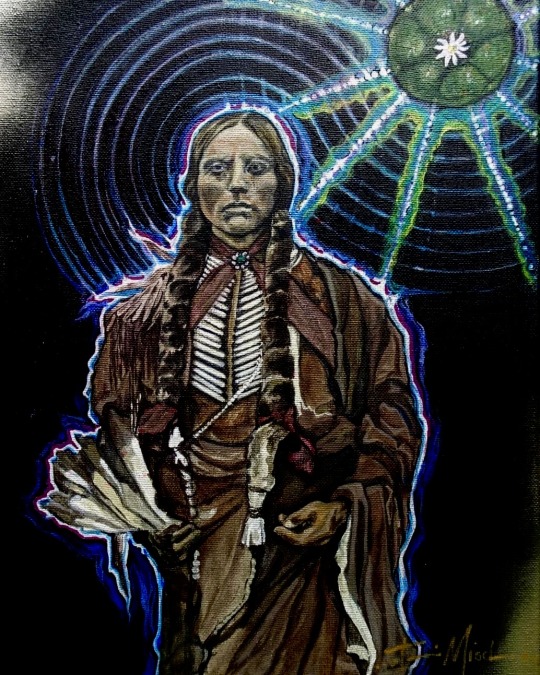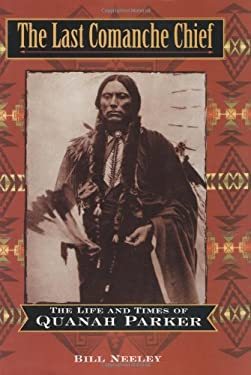#Quanah Parker
Text

QUANAH
Mixed media on canvas
16” x 20”
2020
6 notes
·
View notes
Text

Quanah Parker 🤎🤎🤎🤎
#native american history#quanah parker#native people#native lives matter#native love#lawton oklahoma#cherokee#choctaw#chickasaw#afa evening news#tulsa world
28 notes
·
View notes
Text
Comanche warriors had for centuries taken female captives, of all and any race, and fathered children by them who were raised as Comanches. The kidnapping of a blue-eyed, nine-year-old Cynthia Ann Parker in 1836 would mark the start of the white man's forty-year war with the Comanches, in which Quanah Parker [Cynthia's half-breed son] would become a key figure.
The only borderland where white civilization met hostile Plains Indians was in Texas. Oklahoma was pure Indian territory, where beaten tribes were forcibly relocated, often right on top of warlike plains tribes. The Parkers' land was like the tip of a blunt finger of Anglo civilization jutting out into the last stronghold of untamed Indians in America. In 1836 it was a very dangerous place. There had been recent Comanche raids in the area: a caravan of settlers had been attacked and two women kidnapped; a month later a family had been attacked on the Guadalupe River; two men killed and a woman and her two children taken captive. She had somehow escaped, and later wandered battered, bleeding, and nearly naked into a camp full of astonished Rangers in the middle of the night. As it was, the Parkers were easy prey. They were too new to the western frontier. When a large band of Indians rode up to the fort at ten o'clock in the morning, seventeen-year-old Rachel Parker guessed incorrectly, and perhaps wistfully, that they were "Tawakonis, Caddoes, Keechis, Wacos," and other sedentary bands of central Texas - but they soon realized they had made a disastrous error in leaving themselves so exposed. Had they fully understood whom they were confronting - mostly Comanches, but also some Kiowas, their frequent running mates [and the only other tribe that hunted on horseback] - they might have anticipated the horrors that were about to descend on them.
What happened next is one of the most famous events in the history of the American frontier, as the start of the longest and most brutal of all the wars between Americans and a single Indian tribe.
[Warning: edited descriptions of disturbing violence]
Rachel Parker and her sister watched in horror as the Indians surrounded her uncle and impaled him on their lances, and then [tortured], while probably still alive. This all happened very quickly. Rachel, attempting to run with her fourteen-month old son, was soon caught, and she would write, "a large sulky Indian picked up a hoe and knocked me down." She fainted, and when she came to was being dragged by her long red hair, bleeding profusely from her head wound. Meanwhile three of her relatives were stripped naked and scalped, while her granny was [sexually assaulted] and left for dead, although she would miraculously survive. Two women and three children were taken captive. Two of those children would become household names on the western frontier. The logic of Comanche raids was straightforward: All the men were killed, and any men who were captured alive were tortured to death as a matter of course, some more slowly than others; the captive women were gang-raped. Some were killed, some were tortured. But a portion of them, particularly if they were young, would be spared. Babies were invariably killed, while preadolescents were often adopted by Comanches or other tribes, or sold and ransomed back to the whites for horses, weapons, or food.
-S.C. Gwynne, Empire of the Summer Moon
#comanches#the comanches#kiowa#indigenous#texas#frontier#history#quanah parker#cynthia parker#rachel parker plummer#rachel parker#american history
3 notes
·
View notes
Text
1 note
·
View note
Text
Writers, Research Widely
Empire of the Summer Moon, by S. C. Gwynne, and The Last Comanche Chief, by Bill Neely
Whether you’re a college student writing a paper, professional author, or someone in between, the way you research can determine pass or fail – or maybe something in between. But there are traps for you, the following being one of the most pernicious examples I can imagine.
Some weeks ago I began watching…

View On WordPress
2 notes
·
View notes
Text
Before the rains came the wind drifted across the lake waters then slowly down the Oklahoma Prairie...
Source Me laf@ilyF ❤
#original photographers#colors#artists on tumblr#my photos#oklahoma#my escape#nature#my photgraphy#wichita mountains#photographers on tumblr#my video#quanah parker#lake#water#movement
6 notes
·
View notes
Photo

Quanah Parker
3 notes
·
View notes
Text

Empire of the Summer Moon spans two astonishing stories. The first traces the rise and fall of the Comanches, the most powerful Indian tribe in American history. The second entails one of the most remarkable narratives ever to come out of the Old West: the epic saga of the pioneer woman Cynthia Ann Parker and her mixed-blood son Quanah, who became the last and greatest chief of the Comanches.
Although readers may be more familiar with the tribal names Apache and Sioux, it was in fact the legendary fighting ability of the Comanches that determined when the American West opened up. Comanche boys became adept bareback riders by age six; full Comanche braves were considered the best horsemen who ever rode. They were so masterful at war and so skillful with their arrows and lances that they stopped the northern drive of colonial Spain from Mexico and halted the French expansion westward from Louisiana. White settlers arriving in Texas from the eastern United States were surprised to find the frontier being rolled backward by Comanches incensed by the invasion of their tribal lands.
The war with the Comanches lasted four decades, in effect holding up the development of the new American nation. Gwynne’s exhilarating account delivers a sweeping narrative that encompasses Spanish colonialism, the Civil War, the destruction of the buffalo herds, and the arrival of the railroads, and the amazing story of Cynthia Ann Parker and her son Quanah—a historical feast for anyone interested in how the United States came into being.
Hailed by critics, S. C. Gwynne’s account of these events is meticulously researched, intellectually provocative, and, above all, thrillingly told. Empire of the Summer Moon announces him as a major new writer of American history.
#empire of the summer moon#Empire of the Summer Moon: Quanah Parker and the Rise and Fall of the Comanches#s. c. gwynne#s c gwynne#nonfiction#biography#historical
2 notes
·
View notes
Text

Source Me laf@ilyF ❤
2 notes
·
View notes
Text

7 notes
·
View notes
Text

Quanah Parker on porch ... Date : 1885-1895 ... Quanah Parker, wrapped in blanket, stands on porch in front of door to home ... Note by Dyck on verso "Quoanah Comanche." ...
McCracken Research Library, Buffalo Bill Center of the West
7 notes
·
View notes
Quote
In the 1890's, the American ethnographer James Mooney traveled to the land of the Comanches to gain an understanding of the Comanche Peyote Ceremony. He eventually saw the ritual as a fountain of honesty and of true spiritual inspiration. Mooney soon began to see the medicinal value of the peyote to tribal people as well.
In the encounter with well-known peyote men, Mooney realized that the Comanches were one of the early users of peyote within the teepee ceremony.
As he was welcomed into the Comanche peyote meeting, he observed the gathering very closely. For the meeting, the famed Comanche Chief Quanah Parker who was the main protector of the ceremony had the elder Red Sun command the all-night meeting of fellowship.
Of the respected old great warrior Red Sun who was also known as Puiwat (Without Eyes), Mooney would later share that Puiwat "was blind and very feeble" yet "when it came to his turn to sing the midnight song, he took the rattle and sang as vigorously as any of the others."
After the meeting was over, the Comanche participants posed for a group picture beside their teepee for James Mooney. They were shown posed in front of Quanah Mountain. In his later report at the Smithsonian, Mooney shared that the peyote was not to be feared. It allowed him to pursue a commitment to help preserve tribal ways.
Indigenous Civilization

The noted Comanche Peyote leader Red Sun or Puiwat (Without Eyes), ca. 1893. Photograph taken by W. J. Lenney.
75 notes
·
View notes
Text
Traces of Texas

Traces of Texas
"The Dodge City Peace Commission" in 1883. One of the most famous photos in Old West history. Several men here had Texas roots or spent considerable time here.
Luke Short, whose life story should be a Hollywood movie, was born in Arkansas but moved to Montague County, Texas shortly after birth and grew there. In 1862, Luke witnessed his father being ambushed and attacked by a group of Comanches in their yard. His father was surrounded by the group and attacked with arrows and lances. Inside the house, Luke helped the elder Short by dragging a large rifle to his brother, who then ran and handed it to his father, who successfully fought off the attackers. Later, on the night of February 8, 1887, an argument broke out between Luke Short and Jim Courtright in Fort Worth about the Courtright's persistence in demanding money from Luke's establishment for "protection". Short ended up killing Courtright in one of the Old West's most famous duels.
Bat Masterson was engaged in buffalo hunting on June 27, 1874, when he became an involuntary participant in one of the Wild West's most celebrated Indian fights: a five-day siege by several hundred Comanche, Kiowa and Cheyenne warriors led by Quanah Parker at a collection of ramshackle buildings in the Texas panhandle known as Adobe Walls. Masterson was one of 28 hunters who defended the outpost during the attack. The Comanche suffered the most losses during the battle, though the actual number killed is not known, with reports ranging from a low of 30 to a high of 70. The defenders of Adobe Walls lost only four men, one of whom shot himself by accident. After being fought to a standstill, Quanah Parker and his followers rode off. Later, Masterson was involved in a gunfight in Mobeetie, Texas, and sustained a bullet wound in the pelvis, from which he recovered. But that is why he started carrying his signature cane.

13 notes
·
View notes
Text

Source Me laf@ilyF ❤
#artists on tumblr#original photographers#photographers on tumblr#photography#my photgraphy#colors#oklahoma#mountains#quanah parker#lake#waterlily#boat
5 notes
·
View notes
Text
no western will ever be able to beat the bank robbery (1908). all the actors are genuine lawmen or outlaws. everyone is about sixty. the camerawork is shoddy. half the film is comprised of guys trying to climb onto their horses. the camera always pans after the horses too slowly so the chase scenes are mostly dust. there's that one woman who is the only competent criminal and spends most of her time trying to warn the others that the law is after them. a man gets thrown in a lake. there's a scene from a completely different film right in the middle. quanah parker is there. it was created to fuck with thomas edison. the actors didn't tell anyone they were filming so all the extras are random people who thought there was an actual gunfight going on. it's considered the first film to have the western gunfighting trope. the film is so blurry that it's impossible to see what's going on. quanah is in a waistcoat. just watch it for his amazing fashion sense. the dramatic final battle is rather dampened by the fact that the bad guys are casually walking away rather than running. it sets such a high standard for female and indigenous representation that no later westerns can beat it.
#film of all time#it's absolutely awful and i love it <3#something something if the bank robbery has 100 fans i'm one of them if it has 0 fans then i'm dead#dee rambles#dee's history stuff
5 notes
·
View notes